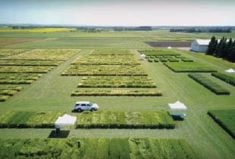The Alberta government has suggested its farm workplace rules are going to be very similar to other provinces
So what does that look like?
Perhaps the best example is Manitoba, where in 2009 the NDP government extended workplace, health and safety rules to farms and made workers’ compensation compulsory.
Doug Chorney was president of Keystone Agricultural Producers, the province’s main farm group, at the time and was deeply involved as the new regulations and enforcement regime came into effect. He remains a member of the province’s workplace safety advisory council that reports to the labour minister.
Most of the questions being asked here were raised in Manitoba and so Alberta Farmer asked Chorney to respond to a few from producers in this province.
Enforcement

“How are they going to come out to the farm and make sure we’re actually living by these rules? How many regulators would you need to run around and make sure every day that safety measures are being followed?” —Jeff Nonay, Legal
Manitoba had a “pretty soft enforcement” when the changes came into effect in 2009.
“They’ve been very engaged, but they’ve been fairly patient with producers,” said Chorney.
“It’s an ongoing process. It’s not something you change in 12 or 24 months. It’s going to take time, and I think for the most part, our government has been pretty understanding of that.”
Rather than taking a hard-line approach to enforcement, the Manitoba government approached it from “an education standpoint.”
Read Also

Grazing ‘sweet spot’ boosts pasture performance
Timing-focused approach to pasture management touted to boost forage growth, livestock gains while also cutting farmer labour and inputs
“There’s usually insufficient resources to go and visit every farm in the province to ensure compliance,” said Chorney. “They’re going to be far more successful if they take the education approach and help producers get into compliance.
“They do understand it’s a learning curve, especially with agriculture.”
Generally, inspectors don’t “nitpick” when enforcing regulations, he added.
“They’re not trying to look at first aid boxes. They’re looking for high-hazard risks — things like enclosed spaces, ladders that are unguarded, unguarded farm machinery,” said Chorney.
“They realize they’re going to save the most amount of producers by identifying and focusing on these high-hazard risks. That’s not to say you can ignore everything else, but that’s the approach they’ve taken in Manitoba.”
There are about 150 Occupational Health and Safety inspectors in Alberta.
Work Hours

“My one biggest concern is the hours that guys are going to be able to work and overtime. It’s hard enough to find people who want to come and work in the ag labour pool. If they all of a sudden start hammering us with overtime and hours of work, I don’t know where we’re supposed to find these people.” — Kevin Serfas, Turin
Regulations around overtime are the same for every workplace in his province, said Chorney.
But farms get cut some slack, he added.
“The government realized that people harvesting crops in the outdoors are subject to a lot of variables beyond the control of the farmer, like weather and challenges getting crops off. In those cases, they were much more accommodating,” said Chorney.
“There are still rules, but they don’t enforce the rules quite the same way.”
The proposal for Alberta in regards to how long someone can work is “12 hours a day except during critical times” — but whether harvest or calving would qualify as a “critical time” isn’t known yet.
However, Chorney said the rules are more rigorous in high-hazard workplaces, so those types of farms are treated the same as a construction worksite.
“There are different rate models for people who work in intensive livestock operations, like people who work in barns that are climate-controlled,” said Chorney.
“We actually have different employment standards for things like overtime if you’re working in a climate controlled barn versus working outdoors.”
Cost

“I’m involved in the oilfield, so I have workers’ compensation for the oil side of things. It’s about a third of the cost for double the yearly income. That’s concerning. The rates are kind of out to lunch. I’d like to see the rates come down a bit.” — Kevin Steeves, Rimbey
Manitoba producers had “a lot of concern” about rates when WCB coverage became mandatory.
“Initially, we had a guarantee from WCB that they would give us a locked-in rate for the first few years,” said Chorney. “It was a pretty competitive rate.”
And by and large, the rates have dropped for most producers, with the exception of farms with major incidents, he said.
“Our experience with the program so far has been that we’ve been able to improve our safety record and incidents have declined such that rates for many producers have gone down,” said Chorney.
Right now, the Manitoba government is also phasing in a rate model change that will change the way farm accidents and fatalities impact rates.
“In the past, the rate model that WCB used was very responsive to incidents,” said Chorney.
“People who had a fatality or a major incident would quickly see their rates climb dramatically.”
Rates in Manitoba, he said, started around $2.40 for every $100 in wages — “a very reasonable rate.” But farms that have had an incident could see their rates rise to $18 for every $100 in wages.
“That gets to be a pretty substantive impact on a producer.”
For the most part, though, the cost of coverage has been “very manageable,” said Chorney.
“We get very little complaint from our members about the cost of WCB. We’re getting a fairly good value for our money with WCB rates in Manitoba.”
The rates proposed for Alberta are $1.70 per $100 of wages for greenhouses and market gardens; $1.75/$100 for hog, poultry, goat, and sheep producers; $2.25/$100 for crop farming, and $2.97/$100 for cattle and dairy producers and feedlots.















